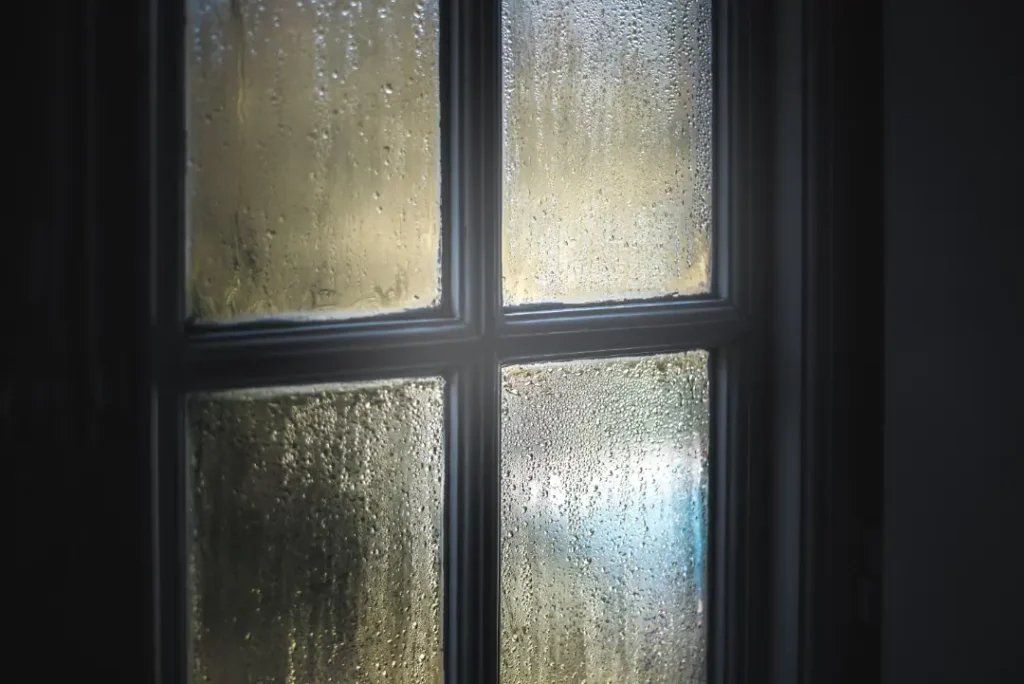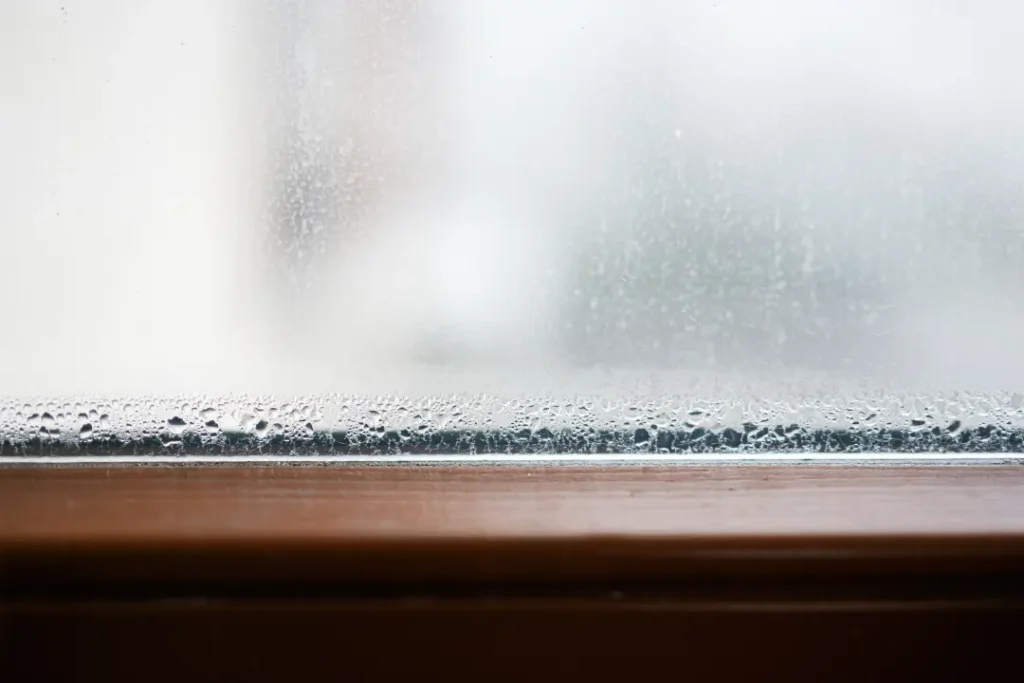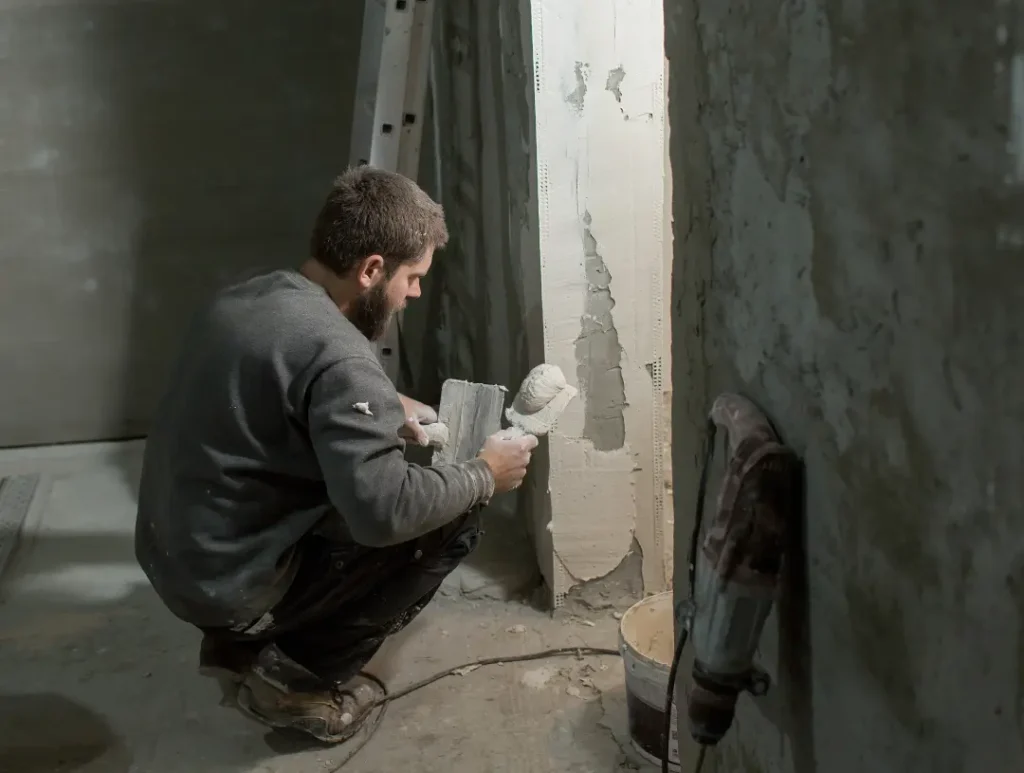Determining whether you’re dealing with damp or condensation is crucial for effective treatment and preventing long-term damage.
Damp and condensation are often confused, but they arise from different causes and require different solutions.
This article will help you understand the differences between damp and condensation, identify their signs, and explore suitable treatments to protect your home.
Key Takeaways
- Damp and condensation are distinct issues; dampness originates from external moisture, while condensation results from warm air meeting cold surfaces.
- Identifying the signs of damp (such as water stains and musty smells) and condensation (like mould and water droplets) is crucial for effective treatment.
- Professional assessment and intervention are often necessary for long-term solutions to damp and condensation problems.
A Brief Overview of Damp and Condensation
Damp and condensation, though frequently confused, differ fundamentally in their origins and implications. Damp refers to the presence of excess moisture within a building’s structure, often arising from external sources like rain or groundwater. On the other hand, condensation occurs when warm, moist air comes into contact with cold surfaces, leading to moisture buildup.
If you misinterpret these issues, it can lead to ineffective treatments and persistent problems. Determining whether the issue is condensation or another damp problem is crucial for selecting the appropriate solution, as each damp problem—such as rising or penetrating damp—requires a different approach. For instance, treating condensation problems with solutions meant for rising damp would be futile and vice versa. This distinction is key to maintaining a healthy, damage-free home.

What is Damp?
Damp, in its simplest terms, is the presence of excess moisture in a building’s structure. This moisture can enter homes through various routes, leading to different types of damp, such as rising damp and penetrating damp. In extreme cases, untreated damp can lead to irreversible water damage that compromises the safety of walls and flooring. Moisture creeping up from the ground may also result in the decay of timber beams and floorboards.
Rising damp is often seen in older buildings where the damp-proof course is either damaged or non-existent. It is characterised by tide marks on walls and skirting boards, indicating moisture rising upwards through capillary action. If left untreated, rising damp can cause serious structural problems, including damage to plaster, timber, and even the building’s foundations.
Penetrating damp occurs when moisture enters a building from outside sources. This can happen due to issues like broken roof tiles or faulty window installations. This type of damp can lead to significant damage to walls and ceilings. It often shows up as damp patches or discolouration. Recognising these signs early is crucial. Understanding them is key to effective damp treatment and prevention.
What is Condensation?
Condensation is a common form of moisture buildup that occurs when warm, moist air meets a colder surface. This interaction causes water vapour to condense into liquid water, forming water droplets on windows, walls, and other surfaces. Unlike rising damp or penetrating damp, condensation damp is primarily an internal issue, often exacerbated by activities that generate high humidity levels, such as cooking, showering, and drying wet clothes indoors.
If condensation is recurring during rainy weather, it may be linked to heat loss through exterior walls or poor insulation. Tackling these issues helps maintain thermal comfort and reduces the likelihood of mould recurrence. Common areas affected by condensation include kitchens, bathrooms, and poorly ventilated spaces like corners of rooms or areas behind furniture.
If left unaddressed, condensation can result in mould growth, which poses serious health risks and can further damage the property. Recognising the signs and understanding how condensation forms are essential initial steps in addressing the problem.
How to Identify the Signs of Damp and Condensation
A damp home, caused by excess moisture, can promote mould growth, damage walls and furniture, and pose significant health risks. Spotting the early signs of damp and condensation helps prevent extensive damage and maintain a healthy home environment.
Damp, condensation, and mould are often interconnected, and their presence can significantly impact a property’s structural integrity and the health of its occupants. It is important to address both mould and damp together—referred to as both mould—to effectively prevent health risks and property damage. Learning to recognise the signs before they escalate can address these issues promptly.
Common Signs of Damp
Penetrating dampness often shows up as water stains or discolouration on walls and ceilings. Persistent stain marks are typical of damp problems and can help distinguish them from condensation, which usually causes black mould patches instead. These damp patches can result from issues such as leaky gutters, broken pipes, or defects in the building’s exterior that allow water to seep in. Addressing these problems early is crucial to preventing further structural damage and maintaining the property’s overall health.
Other common signs of dampness include a musty smell, peeling paint or wallpaper, and the presence of mould spores.
Common Signs of Condensation
Condensation issues often manifest as black mould, particularly in areas with poor ventilation and high humidity, like bathrooms and kitchens. Water droplets on windows and other cold surfaces are telltale signs of mould condensation. These signs indicate that the air in the home is too moist, and steps need to be taken to improve ventilation and reduce humidity levels.
If your home has limited airflow, it may be susceptible to condensation problems. Ensuring proper ventilation, especially in areas prone to moisture buildup, can help mitigate these issues. Early identification and addressing of condensation signs can prevent further damage and health risks from mould growth. Condensation can often be mistaken for other forms of damp, especially when it forms near window frames or corners of rooms. Differentiating between them is essential to avoid wasting money on the wrong treatments.
Causes of Damp vs. Condensation
Understanding the causes of damp and condensation is crucial for resolution. Although both issues involve moisture, they have different sources. Damp typically results from external factors, such as rainwater leaking in, faulty plumbing, and inadequate drainage. On the other hand, condensation is mainly an internal problem. It arises from activities that raise indoor humidity. Insufficient ventilation contributes to this issue.
Mould damp occurs when mould thrives in damp, humid conditions caused by various forms of dampness. Addressing mould damp is essential to maintaining a healthy indoor environment.

Causes of Damp
Damp is commonly caused by:
- Rainwater ingress;
- Defective plumbing;
- Water leaks;
- Poor drainage;
- A damp patch.
These issues allow moisture to enter the building, leading to problems like rising damp and penetrating damp. Regular maintenance checks and prompt repairs of structural vulnerabilities can help prevent damp from becoming a severe issue.
Failed damp-proof courses are another significant cause of dampness, especially in older buildings. Proper drainage systems and maintaining gutters can also prevent water accumulation around the property, reducing the risk of damp issues.
Early identification and addressing of these causes can save homeowners from extensive and costly repairs.
Causes of Condensation
Condensation occurs when moist air meets cool surfaces, leading to moisture buildup. Common causes include inadequate ventilation, high-humidity areas like kitchens and bathrooms, and inadequate heating. Daily activities such as cooking, showering, and drying clothes indoors significantly contribute to humid air levels, exacerbating condensation problems.
To combat condensation, it’s essential to improve ventilation and ensure that the home is adequately heated. Installing extractor fans, using lids on pots while cooking, and drying clothes outside can help reduce moisture production and prevent condensation buildup.
Dealing with these causes helps maintain a healthier and more comfortable living environment.
How Damp and Condensation Affect Indoor Air Quality
The presence of damp and condensation doesn’t just damage your property; it also impacts indoor air quality. Moisture laden environments can encourage the growth of mould, bacteria, and dust mites, leading to respiratory issues and allergic reactions, especially in vulnerable individuals.
When moisture builds up on exterior walls, window frames, and behind doors, it reduces the circulation of fresh air and creates pockets of stagnant air where harmful contaminants can thrive.
Maintaining good indoor air quality requires identifying moisture problems early and addressing both the causes and the affected area properly.
How to Treat Damp and Condensation
Effective treatment of damp and condensation requires a clear understanding of their underlying causes and appropriate intervention methods. While DIY solutions can provide temporary relief, professional assessment and treatment are best for long-term resolution.
At Environ Property Services, we are experts in handling these issues and offer tailored solutions that address both the symptoms and root causes of damp and condensation.
Our professional services ensure effective treatment and help prevent recurrence by addressing structural vulnerabilities and improving ventilation.
Whether dealing with rising damp, penetrating damp, or persistent condensation, a comprehensive approach is essential for maintaining a healthy and damage-free home. A damp specialist can provide the expertise needed for these issues.
Treating Damp
To treat rising damp, consider the following methods:
- Install a chemical damp proof course to prevent moisture from rising through the walls.
- For penetrating damp, fix broken pipes and consider hiring a damp specialist for a thorough survey.
- Install waterproofing membranes on affected external walls to prevent moisture ingress and protect the building’s structure.
Untreated damp can cause serious structural problems, such as dry rot and wet rot, making timely intervention crucial. Addressing damp problems promptly helps prevent extensive damage and mitigates health risks associated with mould and rot.
We will provide tailored solutions for your damp and/or condensation problems, focusing on effective and long-term strategies.
Treating Condensation
Improving ventilation is crucial for reducing condensation, as it helps remove moist air from the home. Installing extractor fans in kitchens and bathrooms can significantly decrease humidity levels, reducing the risk of condensation. Maintaining air circulation by leaving space between furniture and walls can also help prevent cold spots that lead to condensation.
Simple steps like keeping lids on pots while cooking and drying clothes outside can help manage indoor humidity levels. Nevertheless, if condensation problems are not resolved quickly, they can deteriorate plaster and other materials. Promptly addressing these issues ensures a healthier and more comfortable living environment.
How to Prevent Future Damp and Condensation Issues
Proactive measures and regular maintenance are required to prevent future issues with dampness and condensation. Regular inspections and appropriate maintenance can help identify potential problems before they become serious. Preventive steps help you maintain a dry and healthy living environment.
Preventing Damp
Maintaining consistent heating in all rooms can reduce cold spots, which are more prone to damp. Regularly opening windows helps moist air escape, which can prevent damp buildup. Avoiding overstuffing cupboards and ensuring furniture is not placed directly against walls can also promote air circulation and reduce the risk of damp.
Inspecting and maintaining pipes, drains, and gutters can help avoid leaks that contribute to damp conditions. Ventilating appliances like washing machines and tumble dryers externally prevent moisture from accumulating indoors. Ensuring your central heating runs at consistent levels during colder months can prevent temperature drops that lead to moisture problems. This, paired with proper insulation, creates an environment that’s less welcoming to damp.
By taking these preventive measures, you can significantly reduce the risk of damp issues.
Preventing Condensation
Maintaining a 50mm gap between furniture and external walls improves airflow and reduces the chances of damp and mould growth. Using pan lids while cooking reduces steam release, which can contribute to indoor humidity levels. Wiping down cold surfaces after moisture-generating activities helps prevent water accumulation and mould growth.
Preventing cold spots in a home can help reduce the likelihood of condensation and subsequent mould growth. Proper ventilation and maintaining indoor humidity levels are crucial steps in preventing condensation problems. By following these measures, you can create a healthier living environment and avoid the issues associated with condensation.
Get Lasting Protection from Damp and Condensation With Environ Property Services
At Environ Property Services, we understand how distressing damp issues can be for homeowners and business owners. Our dedicated team of damp specialists in London is here to provide you with effective solutions tailored to your unique needs. Whether you’re facing rising damp, penetrating damp, condensation or moisture problems, we are committed to restoring your peace of mind and safeguarding your property.
Our experienced professionals conduct meticulous surveys to identify the precise type of damp affecting your space. This thorough approach ensures that we apply the right treatments, effectively overcoming any damp-related challenges. With our expertise, we help create a safe and healthy environment for you and your loved ones.
We Offer Reliable Damp-Proofing Services
Trusting experts for your damp-proofing needs means you can focus on what truly matters—your home and family. At Environ Property Services, our damp proofing London services are designed with your long-term well-being in mind. We offer high-quality services backed by guarantees, ensuring that your property remains safe and sound for years to come. Our specialists approach every job with care and precision, treating each property as if it were our own. We invite you to experience the reassurance that comes from working with a team that truly cares about your comfort and security. Request a fast quote.

Expertise You Can Trust for Historic Properties
Damp issues can be especially challenging for period properties and historic structures. Our team at Environ Property Services excels in handling these unique buildings, ensuring that we preserve their character while providing top-notch damp-proofing solutions. We blend our technical knowledge with an appreciation for history, allowing us to provide treatments that are both effective and respectful of the property’s heritage.
Our commitment to excellence, combined with our expertise in damp proofing, enables us to deliver reliable solutions for even the most challenging environments. Give yourself peace of mind knowing that your historic property is in capable hands. Contact us today for a consultation.
Common Mistakes Homeowners Make When Dealing With Damp and Condensation
One common mistake is relying solely on cosmetic fixes, such as repainting or applying a spray containing bleach to visible mould, without addressing the root causes behind the moisture. While such methods may temporarily remove black dots and staining, they do nothing to solve structural issues or stop future moisture build up.
Homeowners also often overlook the importance of insulation and proper central heating in preventing cold surfaces that cause condensation. A professional inspection can help differentiate between different forms of damp and suggest the right treatment, rather than relying on generic, ineffective solutions.
Frequently Asked Questions
What is the difference between rising damp and penetrating damp?
Rising damp is caused by moisture rising from the ground through the walls, usually due to a faulty or missing damp proof course. It is often identified by tide marks and damp patches on skirting boards. Penetrating damp, on the other hand, occurs when water enters the building through external walls, roofs, or floors, often as a result of broken roof tiles, leaking gutters, or cracks in the structure.
How can I prevent condensation damp?
To prevent condensation damp, ensure your home is well-ventilated by using extractor fans in kitchens and bathrooms, keeping window vents open, and avoiding drying clothes indoors. Maintaining consistent heating and using a dehumidifier can also help reduce humidity levels and prevent condensation from forming on cold surfaces.
What is the primary difference between damp and condensation?
The primary difference between damp and condensation is that damp arises from external moisture sources infiltrating the property. In contrast, condensation occurs when warm, moist air encounters cold surfaces inside the home.
What are the common signs of penetrating dampness?
Common signs of penetrating damp include water stains or discolouration on walls and ceilings, typically caused by leaky gutters or broken pipes. Addressing these issues promptly can prevent further damage.
How can I prevent condensation in my home?
To prevent condensation in your home, improve ventilation by using extractor fans and drying clothes outside to reduce indoor humidity levels. This will create a more comfortable living environment.
Why is it important to treat damp issues promptly?
Treating damp issues promptly is essential to prevent severe structural damage and health risks from mould exposure. Addressing these problems early can safeguard both your property and your well-being.
Conclusion
Understanding and addressing damp and condensation are pivotal in maintaining a healthy and structurally sound home. You can effectively mitigate these common issues by distinguishing between the two, recognising their signs, understanding their causes, and applying appropriate treatments. Regular maintenance and proactive measures are crucial in preventing future problems and ensuring that your living space remains dry and comfortable.
The expertise and tailored solutions we offer at Environ Property Services provide homeowners with professional support in managing damp and condensation issues.
Our commitment to preserving the integrity of properties, combined with advanced techniques and traditional craftsmanship, ensures long-term protection and peace of mind. So, take the necessary steps today to prevent extensive damage and promote a healthier living environment by contacting us right away. We are here for you.

